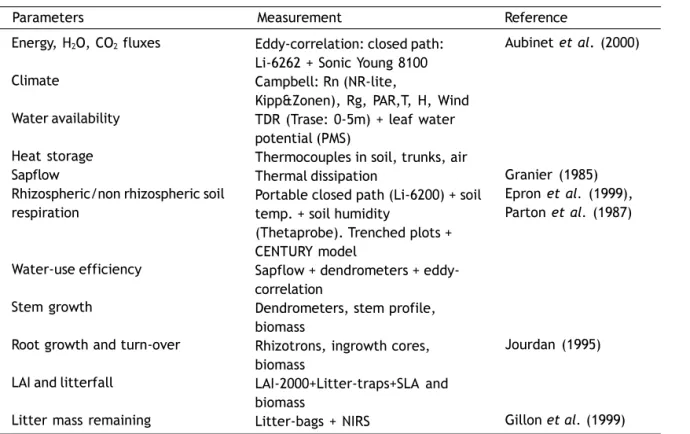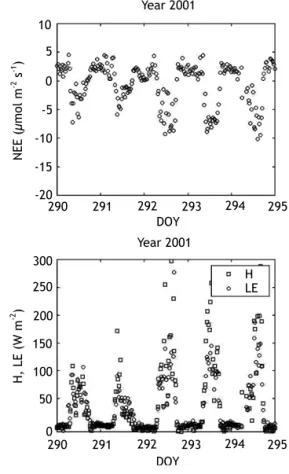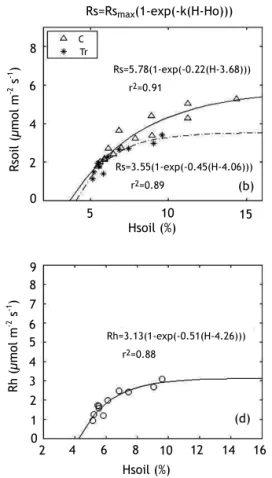HAL Id: hal-02830591
https://hal.inrae.fr/hal-02830591
Submitted on 7 Jun 2020
HAL is a multi-disciplinary open access
archive for the deposit and dissemination of
sci-entific research documents, whether they are
pub-lished or not. The documents may come from
teaching and research institutions in France or
abroad, or from public or private research centers.
L’archive ouverte pluridisciplinaire HAL, est
destinée au dépôt et à la diffusion de documents
scientifiques de niveau recherche, publiés ou non,
émanant des établissements d’enseignement et de
recherche français ou étrangers, des laboratoires
publics ou privés.
Measuring carbon and water fluxes from Eucalyptus
stands in the Congo
Yann Nouvellon, Olivier Roupsard, Olivier Hamel, Welcome Mouvondy,
Daniel Epron, Jean-Marc Bonnefond, Laurent Saint-André, Christophe
Jourdan, André Mabiala, Jean Dauzat, et al.
To cite this version:
Yann Nouvellon, Olivier Roupsard, Olivier Hamel, Welcome Mouvondy, Daniel Epron, et al..
Mea-suring carbon and water fluxes from Eucalyptus stands in the Congo. Workshop on Site Management
and Productivity in Tropical Plantation Forests, Jul 2001, Pointe-Noire, Congo - Brazzaville. CIFOR,
pp.199-204, 2004, 979-3361-41-7. �hal-02830591�
Introduction
In recent years, there has been a growing interest in developing methods to estimate carbon fluxes and sequestration from ecosystems. Following the Kyoto Protocol, carbon sequestration from growing forests may be accounted to help countries to meet their CO2 emissions targets.
Studies on the role of forests in the sequestration of carbon have been facilitated by developments in micrometeorological methods such as eddy covariance (EC), that allows continuous and long-term measurements of water and CO2 fluxes
between the forest and the atmosphere (e.g. Aubinet et al. 2000, Berbigier et al. 2001). These measurements provide valuable information to assess the functional responses of the forests to environmental factors such as water stress, and to develop and validate forest process-based models.
In the Congo, about 42 000 ha of clonal eucalypt plantations have been established on native savannas around Pointe-Noire. A study has been
Measuring Carbon and Water Fluxes from
Eucalyptus Stands in the Congo
Y.Nouvellon1, O. Roupsard2, O. Hamel1, W. Mouvondy3, D. Epron4,
J.M. Bonnefond5, L. Saint-André6, C. Jourdan2, A. Mabiala3, J. Dauzat7,
J.P. Laclau1, J.P. Bouillet1, P. Berbigier5, M. Irvine5 and L. Mounzeo3
1 CIRAD-Forêt/UR2PI, P.O. Box 1291, Pointe-Noire, Congo. Tel: +242-94-3184; Fax: +242-94-4795; Email: cir12@Calva.com 2 CIRAD-CP, Montpellier, France.
3 UR2PI, BP 1291, Pointe-Noire, Congo.
4 Université de Franche-Comté, Besançon, France. 5 INRA, Bordeaux, France.
6 CIRAD-Forêt, Montpellier, France. 7 CIRAD-AMIS, Montpellier, France.
established to measure and model carbon, water and energy exchanges, primary production, stand growth and carbon sequestration from these plantations. The experiment is intended to: (1) estimate carbon stocks (soil and trees) in a clonal chronosequence of eucalypts; and (2) measure water and CO2 fluxes by an eddy correlation
system, meteorological variables, water balance, soil respiration, litter decomposition and tree growth in one stand from the chronosequence, over a two year-period. An overview of this experiment is given in this paper, together with some preliminary results.
Materials and Methods
Experimental Area
The plantations around Pointe-Noire (4OS 12OE;
altitude 50-100 m) are based on two natural hybrids (Eucalyptus PF1, and E. tereticornis x E.
grandis), and the artificial hybrid E. urophylla x E. grandis. They have been established on cleared
200 Measuring Carbon and Water Fluxes from Eucalyptus Stands in the Congo
native savannas, on sandy, ferralitic, and low fertility soils. The climate is characterised by annual rainfall of about 1200 mm, with a dry season between May and September, mean annual temperature of about 25OC, and high relative
humidity (85% on average), with low seasonal variations (2%). The clone selected for this experiment is the clone E. PF1 1-41, the most productive clone of the hybrid E. PF1. This clone covers more than 7000 ha in the planted area.
Estimation of Carbon Stocks in a
Chronosequence
Carbon sequestration by trees and soils is being estimated in a diachronic chronosequence of 21 years (Fig. 1), that is representative of the silviculture applied in these plantations: a first plantation on native savannas followed by a coppice crop and then a new plantation. A replantation chronosequence approach offers several advantages: (1) the age effect over productivity can be accounted for, and (2) regarding carbon sequestration in the soils, chronosequences can be used for cross-validation between estimates obtained from continuous fluxes measurements and estimates obtained from stocks measurements. On the other hand, chronosequence approach may also present
disadvantages such as possible soil variation within the sequence and climate variation during the rotation. Six stands have been selected for carbon storage and soil respiration measurements (Fig. 1): (1) a plantation forest at the end of the first rotation; (2) 7-year-old coppice (end of the second rotation); and (3) 1-, 3-, 4-, and 6-year-old stands in third rotation (replantations). In each of these stands, aboveground, belowground and litter biomass, and carbon stocks in the soils are estimated annually. Tree growth is monitored every 15 days. Soil respiration is periodically measured with a portable closed-path Licor 6200. Root production, lifespan and turnover are estimated from ingrowth cores and rhizotrons.
Measurements of Water and CO
2Fluxes in the 3-year-old Stand
The 3-year-old stand of the third rotation has been selected for continuous measurements of CO2, H2O and sensible heat fluxes using an Eddy
correlation system. These measurements started on September 2000. In this stand (42 ha), tree density is 567 trees ha-1. Between January 2001
and October 2001, mean height and basal area increased from 11.2 to 14.9 m, and from 4.4 to
Table 1. Parameters monitored in eddy-correlation stand
5.8 m2, respectively. Leaf area index (LAI) of the
stand exhibited important seasonal variations, with maximum value (1.6) at the end of the rainy season, and minimum value (0.98) at the end of the dry season.
Flux measurements are obtained from a three-dimensional sonic anemometer (Sonic Young 8100) and a closed path Licor 6262 CO2/H2O analyser,
positioned at 22 m above ground level, on a tower erected in the middle of the stand. Meteorological variables (precipitation, air temperature and relative humidity, net and global radiation, wind speed) are also measured (Table 1). Other measurements on this stand include sap flow measurements (8 trees), soil temperature and water content profiles, litter fall, litter decomposition and soil respiration profiles (Table 1). The parameters obtained on this stand will be used to estimate carbon sequestration, and to validate process-based model of water and CO2
exchanges, tree growth and soil respiration.
Results
Some early results are presented below.
Eddy correlation measurements started at the end of the dry season of year 2000 (end of September 2000). Daily minima of Net Ecosystem Exchanges (NEE) reached values around 20 mmol m-2 s-1
during the rainy season, and 10 mmol m-2 s-1 during
the dry season. Due to an unusual prolongation of the dry season, CO2 fluxes in October 2001 were
lower than in October 2000 (Fig. 2). Most of the diurnal variations in NEE were explained by those of incoming photosynthetic active radiation (PAR). Daily values of NEE varied from around 0 g C m-2
day-1 at the end of the dry season down to around
-4 g C m-2 day-1 during the rainy season, and were
strongly correlated with both the daily incoming PAR, and the daily evapotranspiration estimated from eddy correlation measurements of latent heat flux (LE).
Eddy-correlation: closed path: Li-6262 + Sonic Young 8100 Campbell: Rn (NR-lite,
Kipp&Zonen), Rg, PAR,T, H, Wind TDR (Trase: 0-5m) + leaf water potential (PMS)
Thermocouples in soil, trunks, air Thermal dissipation
Portable closed path (Li-6200) + soil temp. + soil humidity
(Thetaprobe). Trenched plots + CENTURY model
Sapflow + dendrometers + eddy-correlation
Dendrometers, stem profile, biomass
Rhizotrons, ingrowth cores, biomass LAI-2000+Litter-traps+SLA and biomass Litter-bags + NIRS Energy, H2O, CO2 fluxes Climate Water availability Heat storage Sapflow
Rhizospheric/non rhizospheric soil respiration
Water-use efficiency Stem growth
Root growth and turn-over LAI and litterfall
Litter mass remaining
Aubinet et al. (2000) Granier (1985) Epron et al. (1999), Parton et al. (1987) Jourdan (1995) Gillon et al. (1999)
202 Measuring Carbon and Water Fluxes from Eucalyptus Stands in the Congo
respiration was estimated by comparing soil CO2
effluxes obtained from trenched plots to effluxes obtained from the main plot (Fig. 3a). On average, root respiration accounted for 27% of total soil CO2 efflux, while the heterotrophic
component (Rh) accounted for 73% of total soil respiration. For nights with low wind speed, ecosystem respiration could not be directly estimated from EC measurements of NEE, due to CO2 storage in the air layer from the soil surface
to the height at which EC measurements are obtained. As for soil respiration, ecosystem respiration obtained for night with sufficient wind speed showed a marked seasonal pattern, with maximum values obtained during the wet season, and minimum values obtained at the end of the dry season.
Figure 2. Net carbon ecosystem exchange (NEE), sensible heat fluxes (H), and latent heat fluxes (LE), measured by eddy correlation at the Hinda site from day of year (DOY) 290 to DOY 295 in 2000 and 2001
Soil respiration showed a marked seasonal pattern, with maximum values (around 5.3 mmol m-2 s-1) during the wet season, and minimum values
(around 1.5 mmol m-2 s-1) at the end of the dry
season. (Fig. 3a): this pattern was mostly explained by the strong correlations obtained between surface (0-5 cm) soil water content and soil CO2 effluxes (Fig. 3b,d). This soil moisture
effect on soil respiration is easily described by a 3-parameter equation:
Rs = Rsmax{1-exp[-k(H-H0)]}
where Rsmax is the soil respiration for high soil
water content, and H0 is the soil moisture for
which soil respiration tends to zero. The contribution of root respiration to total soil
Figure 3. The seasonal dynamic of soil CO2 efflux on trenched plots (Tr), and on the control plot (C) (a),
and of soil volumetric water content (c), at the Hinda site; Relationship between soil CO2
effluxes and soil water content (b), and between heterotrophic soil respiration (Rh) and soil volumetric water content (d)
Discussion and Conclusions
Carbon sequestration in clonal eucalypt stands in the Congo is being estimated using: (1) carbon stocks measurements over a chronosequence; and (2) continuous, multi-year measurements of carbon exchanges with an eddy correlation system. The first results obtained in a 3-year-old stand have confirmed the major role played by ecosystem respiration in the annual carbon balance of these plantations: more than half of the gross carbon gain (GPP=NEE+Re) was lost through ecosystem respiration. On this 3-year-old stand daily EC estimates of carbon sequestration varied between 0 to 4 g C day-1, depending on soil waterstatus and daily incoming PAR. Fine root production data are being processed to estimate litter production by roots (LR). This information,
together with measurements of above- and belowground living biomass increments (GA, GB),
and litter production by aerial compartment (LA),
will be used to estimate NPP (NPP=GA+GB+LA+LR),
and net carbon gain (NEP=NPP-Rh), that will be compared to the annual net carbon gain estimated by eddy correlation. Other results obtained in this experiment (water and energy fluxes, LAI measurements, etc.) are being used to develop and validate models that simulate the carbon, water and energy budgets of these plantations.
References
Aubinet, A. et al. 2000. Estimates of the annual net carbon and water exchange of forests: the Euroflux methodology. Advances in Ecological Research 30:113-175.
204 Measuring Carbon and Water Fluxes from Eucalyptus Stands in the Congo
Berbigier, P., Bonnefond, J-M. and P. Mellmann. 2001. CO2 and water vapour fluxes for 2 years
above Euroflux forest site. Agriculture and Forestry Meteorology 108:183-197.
Epron, D., Farque, L., Lucot, E. and P-M. Badot. 1999. Soil CO2 efflux in a beech forest: the
contribution of root respiration. Annales Science Forestière 56:289-295.
Gillon, D., Joffre, R. and A. Ibrahima. 1999. Can litter decomposability be predicted by near infrared reflectance spectroscopy? Ecology 80:175-186.
Granier, A. 1985. Une nouvelle méthode pour la mesure du flux de sève dans les troncs des arbres. Annales Science Forestière 42:193-200. Jourdan, C. 1995. Modélisation de larchitecture et du développement du système racinaire du palmier à huile (Elaeis guineensis Jacq.). Académie de Montpellier, Université Montpellier II, Montpellier, France. 241p. Parton, W.J., Schimel, D.S., Cole, C.V. and
Ojima, D.S. 1987. Analysis of factors controlling soil organic matter levels in Great Plains grasslands. Journal of Soil Science Society of America 51:1173-1179.


